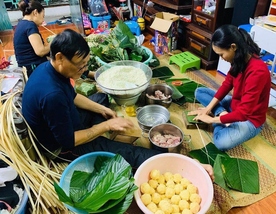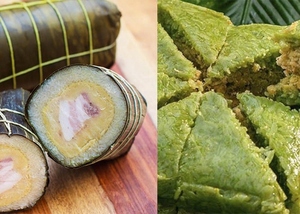Lan, tell us about your cultural experiences! January 2023 Issue
更新日:2023年1月15日
Traditional dish on Lunar New Year in Vietnam
Traditional dish on New Year’s day in Japan is Osechi Ryori, while in Vietnam are “banh chung” and “banh tet”.
“Banh chung” refers to square sticky rice cake which is popular in the northern area, “banh tet” refers to cylindrical sticky rice cake which is popular in the southern area. Both use same ingredients, sticky rice, green gram and pork. However, “banh chung” is wrapped by “dong” leaves while “banh tet” is wrapped by banana leaves. There is also a sweet version of “banh tet” that uses banana and coconut milk instead of pork.
Making “banh chung” and “banh tet” is a little bit difficult and it often takes almost a day from preparation to completion. As the Lunar New Year comes, it is a great time for the whole big family, including relatives, to gather and make “banh chung” and “banh tet” together.
The normal way of eating “banh chung” and “banh tet” is peeling off the leaves and eat, but pan-frying is also a good option.
Vietnamese grocery stores in Matsudo also sell “banh chung” and “banh tet”. So please try if you like.

Family members gather and make “banh chung”, “banh tet” (Photo: Bao Tien Phong)

Banh tet (left), Banh chung (right) (Photo: Bach Hoa Xanh)
ベトナムのお正月の料理
日本のお正月の料理を言えばお節料理ですが、ベトナムのお正月(旧正月)の料理を言えばちまきです。ちまきはベトナムの北部で「バインチュン (banh chung」と、南部で「バインテト(banh tet)」と言います。
北部の「バインチュン」の形は四角で、南部の「バインテト」は筒状です。それから、バインチュンは「ジォン」という植物の葉っぱで包まれているのに対して、バインテトはバナナの葉っぱに包まれています。材料はどちらも同じで、もち米、緑豆と豚肉を使っています。また、バインテトには豚肉の代わりに、バナナとココナッツミルクを使って、味が甘いという種類があります。
ちまきを作るのは少し大変で、準備段階から出来上がるまで、ほぼ一日かかります。旧正月が近づくと、親戚も含め、大家族全員が集まって、お喋りしながらちまきを作るのは楽しい時間となります。
出来上がったちまきは葉っぱを剥いてそのまま食べてもいいですが、葉っぱを剥いたものを一度油で揚げてから食べるのも美味しいです。
松戸市にあるベトナム食材店ではベトナムのちまきも売っていますので、よろしければ買って食べてみてくださいね。

家族が集まってちまきを作る (写真:Bao Tien Phong)

バインテト(左)とバンチュン(右)(写真:Bach Hoa Xanh)
Click to see the full catalogue of Lan's columns コラムの一覧へ


